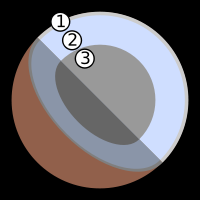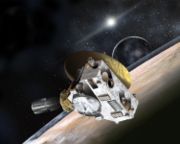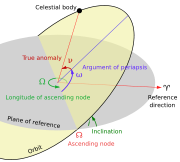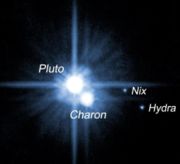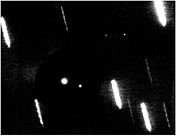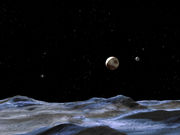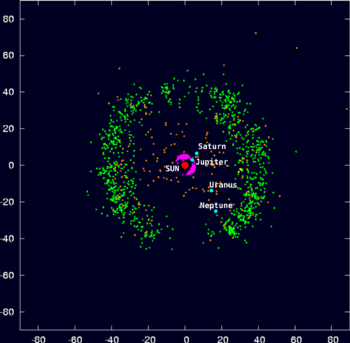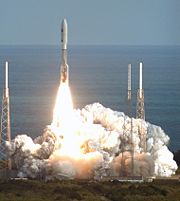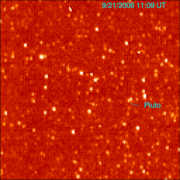Pluto
2008/9 Schools Wikipedia Selection. Related subjects: Space (Astronomy); The Planets
 Map of Pluto based on Charon eclipses, approximately true colour and giving the highest resolution currently possible
|
|||||||
|
Discovery
|
|||||||
|---|---|---|---|---|---|---|---|
| Discovered by | Clyde W. Tombaugh | ||||||
| Discovery date | February 18, 1930 | ||||||
|
Designations
|
|||||||
| MPC designation | 134340 Pluto | ||||||
| Minor planet category |
dwarf planet, TNO, plutoid, and KBO |
||||||
| Adjective | Plutonian | ||||||
|
Orbital characteristics
|
|||||||
| Epoch J2000 | |||||||
| Aphelion | 7,375,927,931 km 49.30503287 AU |
||||||
| Perihelion | 4,436,824,613 km 29.65834067 AU |
||||||
| Semi-major axis | 5,906,376,272 km 39.48168677 AU |
||||||
| Eccentricity | 0.24880766 | ||||||
| Orbital period | 90,613.3055 day 248.09 yr |
||||||
| Synodic period | 366.73 day | ||||||
| Average orbital speed | 4.666 km/s | ||||||
| Inclination | 17.14175° 11.88° to Sun's equator |
||||||
| Longitude of ascending node | 110.30347° | ||||||
| Argument of perihelion | 113.76329° | ||||||
| Satellites | 3 | ||||||
|
Physical characteristics
|
|||||||
| Mean radius | 1,195 km 0.19 Earths |
||||||
| Surface area | 1.795×107 km² 0.033 Earths |
||||||
| Volume | 7.15×109 km³ 0.0066 Earths |
||||||
| Mass | (1.305 ± 0.007)×1022 kg 0.0021 Earths |
||||||
| Mean density | 2.03 ± 0.06 g/cm³ | ||||||
| Equatorial surface gravity | 0.58 m/s² 0.059 g |
||||||
| Escape velocity | 1.2 km/s | ||||||
| Sidereal rotation period |
−6.387230 day 6 d 9 h 17 m 36 s |
||||||
| Equatorial rotation velocity | 47.18 km/h | ||||||
| Axial tilt | 119.591 ± 0.014° (to orbit) | ||||||
| North pole right ascension | 133.046 ± 0.014° | ||||||
| North pole declination | -6.145 ± 0.014° | ||||||
| Albedo | 0.49–0.66 (varies by 35%) | ||||||
| Surface temp. Kelvin |
|
||||||
| Apparent magnitude | up to 13.65 (mean is 15.1) | ||||||
| Absolute magnitude | −0.7 | ||||||
| Angular diameter | 0.065" to 0.115" | ||||||
|
Atmosphere
|
|||||||
| Surface pressure | 0.30 Pa (summer maximum) | ||||||
| Composition | nitrogen, methane | ||||||
Pluto (pronounced /ˈpluːtoʊ/ , from Latin: Plūto, Greek: Πλούτων), formally designated (134340) Pluto, is the second-largest known dwarf planet in the Solar System (after Eris) and the tenth-largest body observed directly orbiting the Sun. Originally classified as a planet, Pluto is now considered the largest member of a distinct region called the Kuiper belt.
Like other members of the Kuiper belt, Pluto is composed primarily of rock and ice and is relatively small: approximately a fifth the mass of the Earth's moon and a third its volume. It has a highly eccentric and highly inclined orbit.
Pluto's eccentricity takes it from 30 to 49 AU (4.4–7.4 billion km) from the Sun, causing Pluto to occasionally come closer to the Sun than Neptune. Pluto and its largest moon, Charon, are often treated together as a binary system because the barycentre of their orbits does not lie within either body. The International Astronomical Union (IAU) has yet to formalise a definition for binary dwarf planets, and until it passes such a ruling, Charon is classified as a moon of Pluto. Pluto has two known smaller moons, Nix and Hydra, discovered in 2005.
From its discovery in 1930 until 2006, Pluto was counted as the Solar System's ninth planet. In the late 20th and early 21st centuries, however, many objects similar to Pluto were discovered in the outer solar system, notably the scattered disc object Eris, which is 27% more massive than Pluto. On August 24, 2006 the IAU defined the term "planet" for the first time. This definition excluded Pluto, which the IAU reclassified as a member of the new category of dwarf planets along with Eris and Ceres. After the reclassification, Pluto was added to the list of minor planets and given the number 134340.
Discovery
In the 1840s, using Newtonian mechanics, Urbain Le Verrier predicted the position of the then-undiscovered planet Neptune after analysing perturbations in the orbit of Uranus. Subsequent observations of Neptune in the late 19th century caused astronomers to speculate that Uranus' orbit was being disturbed by another planet in addition to Neptune. In 1906, Percival Lowell, a wealthy Bostonian who had founded the Lowell Observatory in Flagstaff, Arizona in 1894, started an extensive project in search of a possible ninth planet, which he termed " Planet X". By 1909, Lowell and William H. Pickering had suggested several possible celestial coordinates for such a planet. Lowell and his observatory conducted his search until his death in 1916, but to no avail. Unbeknownst to Lowell, on March 19, 1915, his observatory would capture two faint images of Pluto, but would not recognise them for what they were.
Due to a ten-year legal battle with Constance Lowell, Percival's widow, who attempted to wrest the observatory's million-dollar portion of his legacy for herself, the search for Planet X did not resume until 1929, when its director, Vesto Melvin Slipher, summarily handed the job of locating Planet X to Clyde Tombaugh, a 23-year-old Kansas man who had just arrived at the Lowell Observatory after Slipher had been impressed by a sample of his astronomical drawings.
Tombaugh's task was systematically to image the night sky in pairs of photographs taken two weeks apart, then examine each pair and determine whether any objects had shifted position. Using a machine called a blink comparator, he rapidly shifted back and forth between views of each of the plates, to create the illusion of movement of any objects that had changed position or appearance between photographs. On February 18, 1930, after nearly a year of searching, Tombaugh discovered a possible moving object on photographic plates taken on January 23 and January 29 of that year. A lesser-quality photograph taken on January 21 helped confirm the movement. After the observatory obtained further confirmatory photographs, news of the discovery was telegraphed to the Harvard College Observatory on March 13, 1930.
Naming
The right to name the new object belonged to the Lowell Observatory. Tombaugh urged Slipher to suggest a name for the new object quickly before someone else did. Name suggestions poured in from all over the world. Constance Lowell proposed Zeus, then Lowell, and finally her own first name. These suggestions were disregarded.
The name Pluto was first suggested by Venetia Burney (later Venetia Phair), an eleven-year-old schoolgirl in Oxford, England. Venetia was interested in classical mythology as well as astronomy, and considered the name, one of the alternate names of Hades, the Greek god of the Underworld, appropriate for such a presumably dark and cold world. She suggested it in a conversation with her grandfather Falconer Madan, a former librarian of Oxford University's Bodleian Library. Madan passed the name to Professor Herbert Hall Turner, who then cabled it to colleagues in America.
The object was officially named on March 24, 1930. Each member of the Lowell Observatory was allowed to vote on a short-list of three: " Minerva" (which was already the name for an asteroid), " Cronus" (which had garnered a bad reputation after being suggested by an unpopular astronomer named Thomas Jefferson Jackson See), and Pluto. Pluto received every vote. The name was announced on May 1, 1930. Upon the announcement, Madan gave Venetia five pounds as a reward.
The name Pluto was intended to evoke the initials of the astronomer Percival Lowell, a desire echoed in the P-L monogram that is Pluto's astronomical symbol (![]() ). Pluto's astrological symbol resembles that of Neptune (
). Pluto's astrological symbol resembles that of Neptune (![]() ), but has a circle in place of the middle prong of the trident (
), but has a circle in place of the middle prong of the trident (![]() ).
).
In Chinese, Japanese, Korean and Vietnamese, the name was translated as underworld king star (冥王星), as suggested by Houei Nojiri in 1930. Many other non-European languages use a transliteration of "Pluto" as their name for the object; however, some Indian languages may use a form of Yama, the Guardian of Hell in Hindu mythology, such as the Gujarati Yamdev.
Demise of Planet X
Once found, Pluto's faintness and lack of a resolvable disc cast doubt on the idea that it could be Lowell's Planet X. Throughout the mid-20th century, estimates of Pluto's mass were often revised downward. In 1978, the discovery of Pluto's moon Charon allowed the measurement of Pluto's mass for the first time. Its mass, roughly 0.2 percent that of the Earth, was far too small to account for the discrepancies in Uranus. Subsequent searches for an alternate Planet X, notably by Robert Harrington, failed. In 1993, Myles Standish used data from Voyager 2's 1989 flyby of Neptune, which had revised the planet's total mass downward by 0.5 percent, to recalculate its gravitational effect on Uranus. With the new figures added in, the discrepancies, and with them the need for a Planet X, vanished. Today the overwhelming consensus among astronomers is that Planet X, as Lowell defined it, does not exist. Lowell had made a prediction of Planet X's position in 1915 that was fairly close to Pluto's actual position at that time; however, Ernest W. Brown concluded almost immediately that this was a coincidence, a view still held today.
Physical characteristics
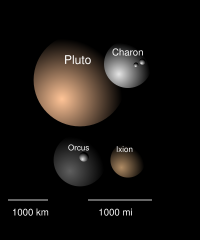
Pluto's distance from Earth makes in-depth investigation difficult. Many details about Pluto will remain unknown until 2015, when the New Horizons spacecraft is expected to arrive there.
Appearance and composition
Pluto's apparent magnitude averages 15.1, brightening to 13.65 at perihelion. To see it, a telescope is required; around 30 cm (12 in) aperture being desirable. It looks indistinct and star-like even in very large telescopes because its angular diameter is only 0.11". It is light brown with a very slight tint of yellow.
Spectroscopic analysis of Pluto's surface reveals it to be composed of more than 98 percent nitrogen ice, with traces of methane and carbon monoxide. Distance and current limits on telescope technology make it impossible to directly photograph surface details on Pluto. Images from the Hubble Space Telescope barely show any distinguishable surface definitions or markings.
The best images of Pluto derive from brightness maps created from close observations of eclipses by its largest moon, Charon. Using computer processing, observations are made in brightness factors as Pluto is eclipsed by Charon. For example, eclipsing a bright spot on Pluto makes a bigger total brightness change than eclipsing a dark spot. Using this technique, one can measure the total average brightness of the Pluto-Charon system and track changes in brightness over time. Maps composed by the Hubble Space Telescope reveal that Pluto's surface is remarkably heterogeneous, a fact also evidenced by its lightcurve and by periodic variations in its infrared spectra. The face of Pluto oriented toward Charon contains more methane ice, while the opposite face contains more nitrogen and carbon monoxide ice. This makes Pluto the second most contrasted body in the Solar System after Iapetus.
The Hubble Space Telescope places Pluto's density at between 1.8 and 2.1 g/cm³, suggesting its internal composition consists of roughly 50–70 percent rock and 30–50 percent ice. Because decay of radioactive minerals would eventually heat the ices enough for them to separate from rock, scientists expect that Pluto's internal structure is differentiated, with the rocky material having settled into a dense core surrounded by a mantle of ice. It is also possible that such heating may continue today, creating a subsurface ocean of liquid water.
Mass and size
Astronomers, assuming Pluto to be Lowell's Planet X, initially calculated its mass on the basis of its presumed effect on Neptune and Uranus. In 1955 Pluto was calculated to be roughly the mass of the Earth, with further calculations in 1971 bringing the mass down to roughly that of Mars. However, in 1976, Dale Cruikshank, Carl Pilcher and David Morrison of the University of Hawaii calculated Pluto's albedo for the first time, finding that it matched that for methane ice; this meant Pluto had to be exceptionally luminous for its size and therefore could not be more than 1 percent the mass of the Earth.
The discovery of Pluto's satellite Charon in 1978 enabled a determination of the mass of the Pluto–Charon system by application of Newton's formulation of Kepler's third law. Once Charon's gravitational effect on Pluto was measured, estimates of Pluto's mass fell to 1.31×1022 kg—less than 0.24 percent that of the Earth. Observations of Pluto in occultation with Charon were able to fix Pluto's diameter at roughly 2,390 km. With the invention of adaptive optics astronomers were able to determine its shape accurately.
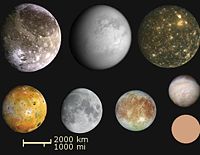
Among the objects of the Solar System, Pluto is not only smaller and much less massive than any planet, but at less than 0.2 lunar masses it is also smaller than seven of the moons: Ganymede, Titan, Callisto, Io, Earth's Moon, Europa and Triton. Pluto is more than twice the diameter and a dozen times the mass of the dwarf planet Ceres, the largest object in the asteroid belt. However, it is smaller than the dwarf planet Eris, a trans-Neptunian object discovered in 2005.
Atmosphere
Pluto's atmosphere consists of a thin envelope of nitrogen, methane, and carbon monoxide, derived from the ices on its surface. As Pluto moves away from the Sun, its atmosphere gradually freezes and falls to the ground. As it edges closer to the Sun, the temperature of Pluto's solid surface increases, causing the ices to sublimate into gas. This creates an anti-greenhouse effect; much like sweat cools the body as it evaporates from the surface of the skin, this sublimation has a cooling effect on the surface of Pluto. Scientists have recently discovered, by use of the Submillimeter Array, that Pluto's temperature is 43 kelvins, 10 K colder than expected.
Pluto was found to have an atmosphere from an occultation observation in 1985; the finding was confirmed and significantly strengthened by extensive observations of another occultation in 1988. When an object with no atmosphere occults a star, the star abruptly disappears; in the case of Pluto, the star dimmed out gradually. From the rate of dimming, the atmospheric pressure was determined to be 0.15 pascal, roughly 1/700,000 that of Earth.
In 2002, another occultation of a star by Pluto was observed and analysed by teams led by Bruno Sicardy of the Paris Observatory, James L. Elliot of MIT, and Jay Pasachoff of Williams College. The atmospheric pressure was estimated to be 0.3 pascal, even though Pluto was farther from the Sun than in 1988 and thus should have been colder and had a more rarefied atmosphere. One explanation for the discrepancy is that in 1987 the south pole of Pluto came out of shadow for the first time in 120 years, causing extra nitrogen to sublimate from the polar cap. It will take decades for the excess nitrogen to condense out of the atmosphere. Another stellar occultation was observed by the MIT-Williams College team of James Elliot, Jay Pasachoff, and a Southwest Research Institute team led by Leslie Young on 12 June 2006 from sites in Australia.
In October 2006, Dale Cruikshank of NASA/Ames Research Centre (a New Horizons co-investigator) and his colleagues announced the spectroscopic discovery of ethane on Pluto's surface. This ethane is produced from the photolysis or radiolysis (i.e., the chemical conversion driven by sunlight and charged particles) of frozen methane on Pluto's surface and suspended in its atmosphere.
Orbit
Pluto's orbit is markedly different from those of the planets. The planets all orbit the Sun close to a flat reference plane called the ecliptic and have nearly circular orbits. In contrast, Pluto's orbit is highly inclined relative to the ecliptic (over 17°) and highly eccentric (elliptical). This high eccentricity leads to a small region of Pluto's orbit lying closer to the Sun than Neptune's. Pluto was last interior to Neptune's orbit between February 7, 1979 and February 11, 1999. Detailed calculations indicate that the previous such occurrence lasted only fourteen years, from July 11, 1735 to September 15, 1749, whereas between April 30, 1483 and July 23, 1503, it had also lasted 20 years.
Although this repeating pattern may suggest a regular structure, in the long term Pluto's orbit is in fact chaotic. While computer simulations can be used to predict its position for several million years (both forward and backward in time), after intervals longer than the Lyapunov time of 10–20 million years, it is impossible to determine exactly where Pluto will be because its position becomes too sensitive to unmeasurably small details of the present state of the solar system. For example, at any specific time many millions of years from now, Pluto may be at aphelion or perihelion (or anywhere in between), with no way for us to predict which. This does not mean that the orbit of Pluto itself is unstable, however, only that its position along that orbit is impossible to determine far into the future. In fact, several resonances and other dynamical effects conspire to keep Pluto's orbit stable, safe from planetary collision or scattering.
Neptune-avoiding orbit
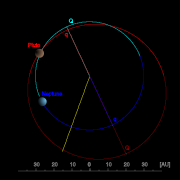
Despite Pluto's orbit apparently crossing that of Neptune when viewed from directly above the ecliptic, the two objects cannot collide. This is because their orbits are aligned so that Pluto and Neptune can never approach closely. Several factors contribute to this.
At the simplest level, one can examine the two orbits and see that they do not intersect. When Pluto is closest to the Sun, and hence closest to Neptune's orbit as viewed in a top-down projection, it is also the farthest above the ecliptic. This means Pluto's orbit actually passes above that of Neptune, preventing a collision. Indeed, the part of Pluto's orbit that lies as close or closer to the Sun than that of Neptune lies about 8 AU above the ecliptic, and so a similar distance above Neptune's orbit. Pluto's ascending node, the point at which the orbit crosses the ecliptic, is currently separated from Neptune's by over 21°; their descending nodes are separated by a similar angular distance (see diagram). Since Neptune's orbit is almost flat with respect to the ecliptic, Pluto is far above it by the time the two orbits cross.
This alone is not enough to protect Pluto; perturbations (e.g., orbital precession) from the planets, particularly Neptune, would adjust Pluto's orbit, so that over millions of years a collision could be possible. Some other mechanism or mechanisms must therefore be at work. The most significant of these is a mean motion resonance with Neptune.
Pluto lies in the 3:2 mean motion resonance of Neptune: for every three orbits of Neptune around the Sun, Pluto makes two. The two objects then return to their initial positions and the cycle repeats, each cycle lasting about 500 years. This pattern is configured so that, in each 500-year cycle, the first time Pluto is near perihelion Neptune is over 50° behind Pluto. By Pluto's second perihelion, Neptune will have completed a further one and a half of its own orbits, and so will be a similar distance ahead of Pluto. In fact, the minimum separation of Pluto and Neptune is over 17 AU; Pluto actually comes closer (11 AU) to Uranus than it does to Neptune.
The 3:2 resonance between the two bodies is highly stable, and is preserved over millions of years. This prevents their orbits from changing relative to one another — the cycle always repeats in the same way — and so the two bodies can never pass near to each other. Thus, even if Pluto's orbit were not highly inclined the two bodies could never collide.
Other factors governing Pluto's orbit
Numerical studies have shown that over periods of millions of years, the general nature of the alignment between Pluto's and Neptune's orbits does not change. However, there are several other resonances and interactions that govern the details of their relative motion, and enhance Pluto's stability. These arise principally from two additional mechanisms (in addition to the 3:2 mean motion resonance).
First, Pluto's argument of perihelion, the angle between the point where it crosses the ecliptic and the point where it is closest to the Sun, librates around 90°. This means that when Pluto is nearest the Sun, it is at its farthest above the plane of the solar system, preventing encounters with Neptune. This is a direct consequence of the Kozai mechanism, which relates the eccentricity of an orbit to its inclination, relative to a larger perturbing body — in this case Neptune. Relative to Neptune, the amplitude of libration is 38°, and so the angular separation of Pluto's perihelion to the orbit of Neptune is always greater than 52° (= 90°–38°). The closest such angular separation occurs every 10,000 years.
Second, the longitudes of ascending node of the two bodies — the points where they cross the ecliptic - are in near-resonance with the above libration. When the two longitudes are the same — that is, when one could draw a straight line through both nodes and the Sun — Pluto's perihelion lies exactly at 90°, and it comes closest to the Sun at its peak above Neptune's orbit. In other words, when Pluto most closely intersects the plane of Neptune's orbit, it must be at its farthest beyond it. This is known as the 1:1 superresonance.
To understand the nature of the libration, imagine a polar point of view, looking down on the ecliptic from a distant vantage point where the planets orbit counter-clockwise. After passing the ascending node, Pluto is interior to Neptune's orbit and moving faster, approaching Neptune from behind. The strong gravitational pull between the two causes angular momentum to be transferred to Pluto, at Neptune's expense. This moves Pluto into a slightly larger orbit, where it travels slightly slower, in accordance with Kepler's third law. As its orbit changes, this has the gradual effect of changing the pericentre and longitudes of Pluto (and, to a lesser degree, of Neptune). After many such repetitions, Pluto is sufficiently slowed, and Neptune sufficiently speeded up, that Neptune begins to catch Pluto at the opposite side of its orbit (near the opposing node to where we began). The process is then reversed, and Pluto loses angular momentum to Neptune, until Pluto is sufficiently speeded up that it begins to catch Neptune once again at the original node. The whole process takes about 20,000 years to complete.
Moons
Pluto has three known natural satellites: Charon, first identified in 1978 by astronomer James Christy; and two smaller moons, Nix and Hydra, both discovered in 2005.
The Plutonian moons are unusually close to Pluto, compared to other observed systems. Moons could potentially orbit Pluto up to 53% (or 69%, if retrograde) of the Hill sphere radius, the stable gravitational zone of Pluto's influence. For example, Psamathe orbits Neptune at 40% of the Hill radius. In the case of Pluto, only the inner 3% of the zone is known to be occupied by satellites. In the discoverers’ terms, the Plutonian system appears to be "highly compact and largely empty."
Charon
The Pluto-Charon system is noteworthy for being the largest of the solar system's few binary systems, defined as those whose barycentre lies above the primary's surface ( 617 Patroclus is a smaller example). This and the large size of Charon relative to Pluto has led some astronomers to call it a dwarf double planet. The system is also unusual among planetary systems in that each is tidally locked to the other: Charon always presents the same face to Pluto, and Pluto always presents the same face to Charon. If one were standing on Pluto's near side, Charon would hover in the sky without moving; if one were to travel to the far side, one would never see Charon at all. In 2007, observations by the Gemini Observatory of patches of ammonia hydrates and water crystals on the surface of Charon suggested the presence of active cryo-geysers.
| Name ( Pronunciation key) |
Diameter (km) | Mass (kg) | Orbital radius (km) (barycentric) |
Orbital period (d) | |
|---|---|---|---|---|---|
| Pluto | /ˈpluːtəʊ/ | 2,306 (65% Moon) |
1.305 (7)×1022 (18% Moon) |
2,040 (100) (0.6% Moon) |
6.3872 (25% Moon) |
| Charon | /ˈʃɛərən, ˈkɛərən/ | 1,205 (35% Moon) |
1.52 (7)×1021 (2% Moon) |
17,530 (90) (5% Moon) |
|
Nix and Hydra
Two additional moons of Pluto were imaged by astronomers working with the Hubble Space Telescope on May 15, 2005, and received provisional designations of S/2005 P 1 and S/2005 P 2. The International Astronomical Union officially named Pluto's newest moons Nix (or Pluto II, the inner of the two moons, formerly P 2) and Hydra (Pluto III, the outer moon, formerly P 1), on June 21, 2006.
These small moons orbit Pluto at approximately two and three times the distance of Charon: Nix at 48,700 kilometres and Hydra at 64,800 kilometres from the barycenter of the system. They have nearly circular prograde orbits in the same orbital plane as Charon, and are very close to (but not in) 4:1 and 6:1 mean motion orbital resonances with Charon.
Observations of Nix and Hydra to determine individual characteristics are ongoing. Hydra is sometimes brighter than Nix, suggesting either that it is larger or that different parts of its surface may vary in brightness. Sizes are estimated from albedos. The moons' spectral similarity to Charon suggests a 35% albedo similar to Charon's; this value results in diameter estimates of 46 kilometres for Nix and 61 kilometres for the brighter Hydra. Upper limits on their diameters can be estimated by assuming the 4% albedo of the darkest Kuiper Belt objects; these bounds are 137 ± 11 km and 167 ± 10 km, respectively. At the larger end of this range, the inferred masses are less than 0.3% that of Charon, or 0.03% of Pluto's.
The discovery of the two small moons suggests that Pluto may possess a variable ring system. Small body impacts can create debris that can form into planetary rings. Data from a deep optical survey by the Advanced Camera for Surveys on the Hubble Space Telescope suggest that no ring system is present. If such a system exists, it is either tenuous like the rings of Jupiter or is tightly confined to less than 1,000 km in width.
In imaging the Plutonian system, observations from Hubble placed limits on any additional moons. With 90% confidence, no additional moons larger than 12 km (or a maximum of 37 km with an albedo of 0.041) exist beyond the glare of Pluto 5 arcseconds from the dwarf planet. This assumes a Charon-like albedo of 0.38; at a 50% confidence level the limit is 8 kilometres.
Kuiper belt
Pluto's origin and identity have long puzzled astronomers. In the 1950s it was suggested that Pluto was an escaped moon of Neptune, knocked out of orbit by its largest current moon, Triton. This notion has been heavily criticised because, as explained above, Pluto never actually comes near the planet.
Beginning in 1992, astronomers began to discover a large population of small icy objects beyond Neptune that were similar to Pluto not only in orbit but also in size and composition. This belt, known as the Kuiper belt after one of the astronomers who first speculated on the nature of a trans-Neptunian population, is believed to be the source of many short-period comets. Astronomers now believe Pluto to be the largest of the known Kuiper belt objects (KBOs). Like other KBOs, Pluto shares features with comets; for example, the solar wind is gradually blowing Pluto's surface into space, in the manner of a comet. If Pluto were placed as near to the Sun as Earth, it would develop a tail, as comets do.
Though Pluto is the largest of the Kuiper belt objects discovered so far, Triton, which is slightly larger than Pluto, shares many atmospherical and geological composition similarities with Pluto and is believed to be a captured Kuiper belt object. Eris (see below) is also larger than Pluto but is not strictly considered a member of the Kuiper belt population. Rather, it is considered a member of a linked population called the scattered disc.
A large number of Kuiper belt objects, like Pluto, possess a 3:2 orbital resonance with Neptune. KBOs with this orbital resonance are called " plutinos", after Pluto.
Exploration of Pluto
Pluto presents significant challenges for spacecraft because of its small mass and great distance from Earth. Voyager 1 could have visited Pluto, but controllers opted instead for a close flyby of Saturn's moon Titan, resulting in a trajectory incompatible with a Pluto flyby. Voyager 2 never had a plausible trajectory for reaching Pluto. No serious attempt to explore Pluto via spacecraft occurred until the last decade of the 20th century. In August 1992, JPL scientist Robert Staehle telephoned Pluto's discoverer, Clyde Tombaugh, requesting permission to visit his planet. "I told him he was welcome to it," Tombaugh later remembered, "though he's got to go one long, cold trip." Despite this early momentum, in 2000, NASA cancelled the Pluto Kuiper Express mission, citing increasing costs and launch vehicle delays.
After an intense political battle, a revised mission to Pluto, dubbed New Horizons, was granted funding from the US government in 2003. New Horizons was launched successfully on January 19, 2006. The mission leader, S. Alan Stern, confirmed that some of the ashes of Clyde Tombaugh, who died in 1997, had been placed aboard the spacecraft.
In early 2007 the craft made use of a gravity assist from Jupiter. Its closest approach to Pluto will be on July 14, 2015; scientific observations of Pluto will begin 5 months prior to closest approach and will continue for at least a month after the encounter. New Horizons captured its first (distant) images of Pluto in late September 2006, during a test of the Long Range Reconnaissance Imager (LORRI). The images, taken from a distance of approximately 4.2 billion kilometres, confirm the spacecraft's ability to track distant targets, critical for maneuvering toward Pluto and other Kuiper Belt objects.
New Horizons will use a remote sensing package that includes imaging instruments and a radio science investigation tool, as well as spectroscopic and other experiments, to characterise the global geology and morphology of Pluto and its moon Charon, map their surface composition and analyse Pluto's neutral atmosphere and its escape rate. New Horizons will also photograph the surfaces of Pluto and Charon.
Discovery of moons Nix and Hydra may present unforeseen challenges for the probe. Debris from collisions between Kuiper belt objects and the smaller moons, with their relatively low escape velocities, may produce a tenuous dusty ring. Were New Horizons to fly through such a ring system, there would be an increased potential for micrometeorite damage that could disable the probe.
Planetary status controversy
Pluto's official status as a planet has been a subject of controversy since at least 1992, when the first Kuiper Belt Object, (15760) 1992 QB1, was discovered. Since then, further discoveries have intensified the debate.
Commemoration as a planet
Pluto is shown as a planet on the Pioneer plaque, an inscription on the space probes Pioneer 10 and Pioneer 11, launched in the early 1970s. The plaque, intended to give information about the origin of the probes to any alien civilization that might in the future encounter the vehicles, includes a diagram of our solar system, showing nine planets. Similarly, an analog image contained within the Voyager Golden Record included on the probes Voyager 1 and Voyager 2 (also launched in the 1970s) includes data regarding Pluto and again shows it as the ninth planet. The Disney character Pluto, introduced in 1930, was also named in honour of the planet. In 1941, Glenn T. Seaborg named the newly created element plutonium in Pluto's honour, in keeping with the tradition of naming elements after newly discovered planets (uranium after Uranus and neptunium after Neptune, although this tradition is also used for some non-planets: cerium is named after Ceres and palladium after Pallas).
New discoveries ignite debate
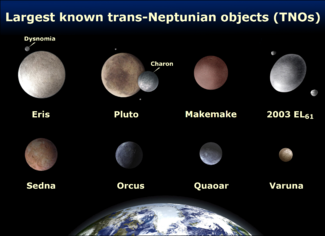
The discovery of the Kuiper belt and Pluto's relation to it led many to question whether Pluto could be considered separately from others in its population. In 2002, the KBO 50000 Quaoar was discovered, with a diameter of roughly 1,280 kilometres, about half that of Pluto. In 2004, the discoverers of 90377 Sedna placed an upper limit of 1,800 kilometres on its diameter, near Pluto's diameter of 2,320 kilometres. Just as Ceres eventually lost its planet status after the discovery of the other asteroids, so, it was argued, Pluto should be reclassified as one of the Kuiper belt objects.
On July 29, 2005, the discovery of a new Trans-Neptunian object was announced. Named Eris, it is now known to be slightly larger than Pluto. This was the largest object discovered in the solar system since Triton in 1846. Its discoverers and the press initially called it the "tenth planet", although there was no official consensus at the time on whether to call it a planet. Others in the astronomical community considered the discovery the strongest argument for reclassifying Pluto as a minor planet.
The last remaining distinguishing features of Pluto were now its large moon, Charon, and its atmosphere. These characteristics are probably not unique to Pluto: several other Trans-Neptunian objects have satellites, and Eris's spectrum suggests that its surface has a composition similar to Pluto's. It also possesses a moon, Dysnomia, discovered in September 2005.
Museum and planetarium directors occasionally created controversy by omitting Pluto from planetary models of the solar system. Some omissions were intentional; the Hayden Planetarium reopened after renovation in 2000 with a model of only eight planets. The controversy made headlines at the time.
IAU decision to reclassify Pluto
The debate came to a head in 2006 with an IAU resolution that created an official definition for the term "planet". According to this resolution, there are three main conditions for an object to be considered a 'planet':
- The object must be in orbit around the Sun.
- The object must be massive enough to be a sphere by its own gravitational force. More specifically, its own gravity should pull it into a shape of hydrostatic equilibrium.
- It must have cleared the neighbourhood around its orbit.
Pluto fails to meet the third condition, since its mass was only 0.07 times that of the mass of the other objects in its orbit (Earth's mass, by contrast, is 1.7 million times the remaining mass in its own orbit). The IAU further resolved that Pluto be classified in the simultaneously created dwarf planet category, and that it act as the prototype for the plutoid category of trans-Neptunian objects, in which it would be separately, but concurrently, classified.
On September 13, 2006, the IAU included Pluto, Eris, and the Eridian moon Dysnomia in their Minor Planet Catalogue, giving them the official minor planet designations "(134340) Pluto", "(136199) Eris", and "(136199) Eris I Dysnomia". If Pluto had been given a minor planet name upon its discovery, the number would have been a little over a thousand rather than over 100,000. The first minor planet to be found after Pluto was 1164 Kobolda, a month later.
There has been some resistance within the astronomical community toward the reclassification. Alan Stern, principal investigator with NASA's New Horizons mission to Pluto, has publicly derided the IAU resolution, stating that "the definition stinks, for technical reasons." Stern's current contention is that by the terms of the new definition Earth, Mars, Jupiter, and Neptune, all of which share their orbits with asteroids, would be excluded. His other claim is that because less than five percent of astronomers voted for it, the decision was not representative of the entire astronomical community. Marc W. Buie of the Lowell observatory has voiced his opinion on the new definition on his website and is one of the petitioners against the definition. Others have supported the IAU. Mike Brown, the astronomer who discovered Eris, said "through this whole crazy circus-like procedure, somehow the right answer was stumbled on. It’s been a long time coming. Science is self-correcting eventually, even when strong emotions are involved."
Among the general public, reception is mixed. Some have accepted the reclassification; others seek to overturn the decision with online petitions urging the IAU to consider reinstatement. A resolution introduced by some members of the California state assembly light-heartedly denounces the IAU for "scientific heresy," among other crimes. The U.S. state of New Mexico's House of Representatives passed a resolution declaring that, in honour of Tombaugh, a longtime resident of that state, Pluto will always be considered a planet while in New Mexican skies, with March 13 being known as "Pluto Planet Day". Some reject the change for sentimental reasons, citing that they have always known Pluto as a planet and will continue to do so regardless of the IAU decision. Others view this rejection as an attempt to bend the rules in order to keep the only planet discovered by an American classified as such.
The ongoing debate over the status of Pluto continues to be acknowledged by the Jet Propulsion Laboratory which, as recently as January 2008, continued to reference it on JPL Photojournal webpages dedicated to Pluto. Researchers on both sides of the debate will gather in August 2008 at Johns Hopkins University for a conference that includes back-to-back talks on the current IAU definition of a planet.
"Plutoed"
The verb "to pluto" ( preterite and past participle: "plutoed") is a neologism coined in the aftermath of the decision. In January 2007, the American Dialect Society chose "plutoed" as its 2006 Word of the Year, defining "to pluto" as "to demote or devalue someone or something", "as happened to the former planet Pluto when the General Assembly of the International Astronomical Union decided Pluto no longer met its definition of a planet."
Society president Cleveland Evans stated the reason for the organization's selection of "plutoed": "Our members believe the great emotional reaction of the public to the demotion of Pluto shows the importance of Pluto as a name. We may no longer believe in the Roman god Pluto, but we still have a sense of connection with the former planet."

